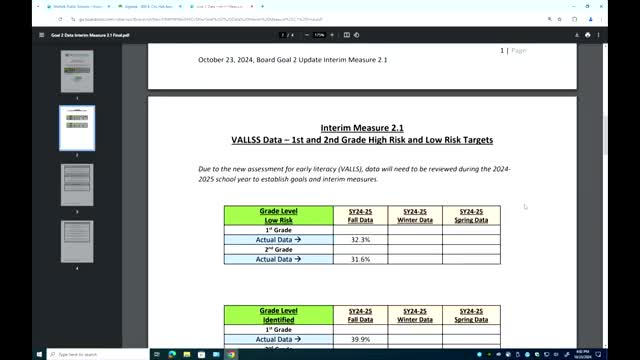New literacy assessment reveals alarming reading risks for students
October 24, 2024 | NORFOLK CITY PBLC SCHS, School Districts, Virginia
Thanks to Scribe from Workplace AI , all articles about Virginia are free for you to enjoy throughout 2025!

This article was created by AI using a video recording of the meeting. It summarizes the key points discussed, but for full details and context, please refer to the video of the full meeting. Link to Full Meeting
The meeting highlighted the strengths and weaknesses identified in the assessment results. First graders excelled in identifying letter names and phoneme blending, but struggled with letter sounds and real-world decoding. Second graders showed similar patterns, performing well in letter names and phoneme blending but facing challenges in phoneme segmenting and passage retelling.
To address these challenges, officials outlined several next steps, including ongoing professional development for teachers and literacy tutors, targeted small group tutoring for high-risk students, and the development of individualized reading plans. These plans will be crucial for students in grades K-3 who fall into the high-risk category, as mandated by the Virginia Literacy Act.
The meeting also touched on the correlation between the VALS assessment and the Standards of Learning (SOL) assessments. While no formal correlation studies have been conducted yet, officials expressed confidence that the new assessment's focus on the science of reading will enhance early literacy instruction and ultimately improve SOL outcomes.
Concerns were raised about the need for additional resources, particularly more early literacy tutors, to support the growing number of students requiring individualized instruction. Currently, there are 82 part-time tutors across elementary schools, but officials acknowledged that more could be beneficial.
In addition to academic support, the meeting emphasized the importance of engaging families in the literacy process. Resources and strategies for home support will be made available through the district's literacy plan website and community events aimed at educating parents on effective literacy practices.
As the school year progresses, officials remain committed to monitoring student progress and adjusting interventions to ensure that all students achieve reading proficiency by the end of third grade.
Converted from School Board Business Meeting: 10-23-24 meeting on October 24, 2024
Link to Full Meeting
Comments
View full meeting
This article is based on a recent meeting—watch the full video and explore the complete transcript for deeper insights into the discussion.
View full meeting